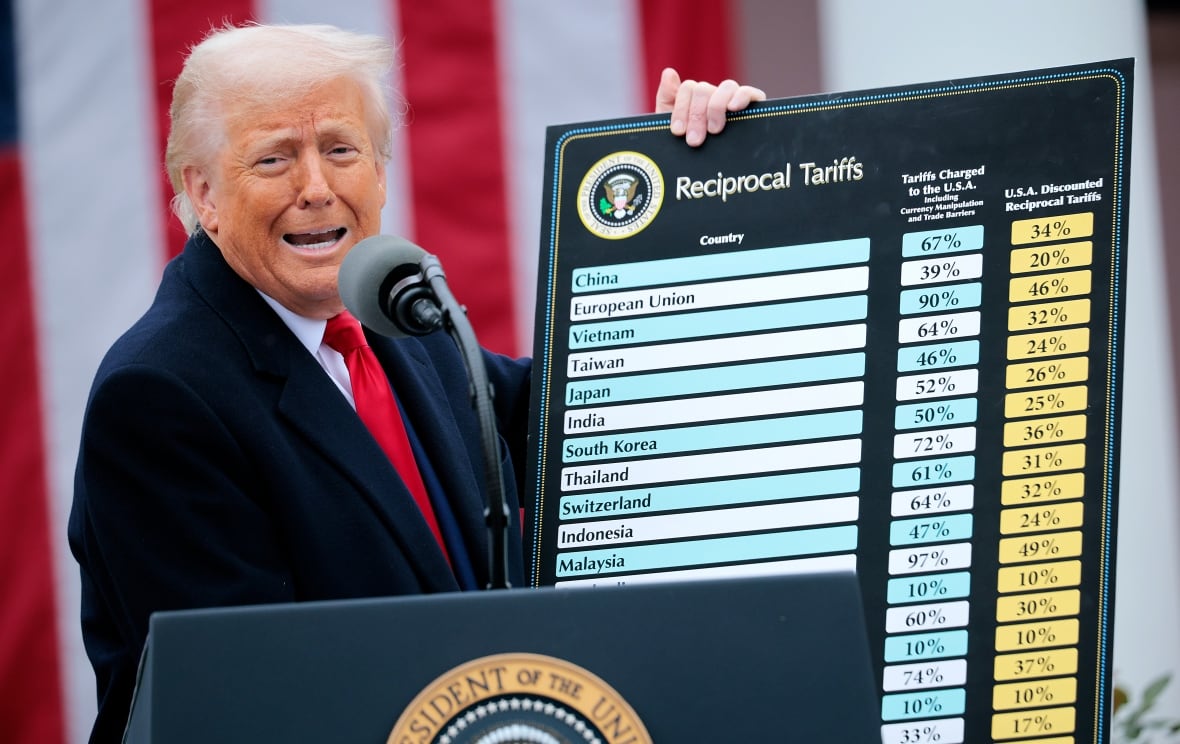Where the world stands with Trump's tariffs
Many countries are still trying to strike deals to avoid punishingly high rates

Countries around the world are in a race against time as they try to secure tariff deals with the United States before they're hit with U.S. President Donald Trump's self-imposed deadlines.
The legality of Trump's tariffs, which affect every country in the world, are now in question. On Wednesday, the U.S. Court of International Trade in New York ruled most of them illegal, in particular the 10 per cent "baseline" tariff all nations (except Canada and Mexico) are now paying.
The Trump administration filed an emergency motion, and on Thursday, the U.S. Court of Appeals for the Federal Circuit allowed Trump to continue collecting tariffs under an emergency powers law for now, as his administration appeals Wednesday's ruling.
The trade court ruling did not strike down 25 per cent auto tariffs, as well as 25 per cent tariffs on steel and aluminum that apply globally, including in Canada.
In the past few months, Trump has imposed, paused, cancelled or altered tariffs and deadlines many times. In recent days, investors have taken to calling it TACO trade, meaning "Trump Always Chickens Out."
Between court rulings and Trump's own decision-making, the facts could change at any moment. But for now, here's where we're at.
Canada and Mexico
Because of their pre-existing free-trade agreement with the U.S., Canada and Mexico avoided the 10 per cent "baseline" tariff. Both still face a 25 per cent tariff for allowing fentanyl to cross the border, but that was also ruled illegal by the U.S. trade court on Wednesday, so its future is uncertain.
What happened to Liberation Day tariffs?
On April 2, Trump stood in the Rose Garden of the White House and held up a chart showing the punishing tariff levels he was imposing on virtually every country in the world, including some uninhabited islands.
He called them "reciprocal" tariffs, and said they were based on a previously unused formula based on trade deficits.

Many countries, including long-standing allies, faced rates of 25 to 30 per cent or more. For any country not on his list, Trump said the 10 per cent "baseline" tariff would apply.
On April 9, the president backed down on the reciprocal tariffs, saying he would put them on pause for 90 days, until July 9, to allow each country to negotiate.
Most countries are now eyeing that date with increasing trepidation, as there is an expectation that higher tariffs will return.
John Waldron, the president of Goldman Sachs, told an investor conference he thinks the U.S. will keep the 10 per cent baseline tariff and reimpose higher rates on some countries, the Financial Times reported.
China
China is the world's biggest exporter, but in contrast to many other countries, it has shown little enthusiasm for negotiating with Trump. Officials did talk to the Trump administration in order to reduce tariffs of 145 per cent down to 30, which took effect on May 14. But the higher rate was not cancelled, only paused for 90 days.
China is currently charging a 10 per cent tariff on U.S. goods as retaliation.
Last week Trump threatened a 25 per cent tariff on iPhones, later adding Samsung phones, most of which are still made in China. The levy is scheduled to take effect at the end of June, but it's also subject to legal challenges, and it's not clear if the president has the power to impose it.
Europe
Last Friday, Trump expressed frustration with the European Union, saying it was moving too slowly. So he said he would impose 50 per cent tariffs on the bloc starting June 1. A few days later, he backed down, saying he would delay until July 9, after the EU agreed to speed up talks.
The EU has so far not imposed retaliatory tariffs on the U.S. It has approved a 21 billion euro package of tariffs on U.S. agricultural products, clothing and Harley-Davidson motorcycles that would take effect on July 14 if no deal is reached. The EU is also considering another 95 billion euros of tariffs on cars, bourbon and Boeing, but those haven't yet been finalized.
Other big players
The U.K. was the first country to secure a deal, although many critics say it was far less impressive than Trump and British Prime Minister Keir Starmer made it out to be. It included a break on 25 per cent auto tariffs, but it left the 10 per cent "baseline" tariff in place.
Japan was initially hit with 24 per cent reciprocal tariffs, which it warned would devastate its economy. Prime Minister Shigeru Ishiba spoke to Trump on the phone on Thursday, saying it was "meaningful" but offered no details.
South Korea was initially hit with 26 per cent tariffs. The trade minister has already warned there may not be enough time to strike a deal with the U.S. before July 9. That's because South Korea is holding a presidential election on June 3, so it doesn't know who its next leader will be.
India initially faced 27 per cent tariffs. The Financial Times reported on Thursday that India is planning to offer cuts to some of its own tariffs in the hopes of striking a deal with the U.S. But those talks are said to be in the early stages.
Smaller countries
Vietnam and Cambodia were hit with extremely high tariffs of 46 and 49 per cent, respectively, because they export huge amounts to the U.S. but import little.
Many other smaller nations are in a similar situation, and it's unclear if there is enough time for the U.S. to negotiate separate trade deals with each one before July 9.
With files from The Associated Press


